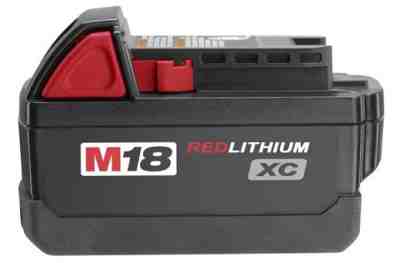When Milwaukee originally announced RedLithium batteries back in 2010, they replaced the original line of M12 and M18 lithium-ion packs. Not content to simply accept a fancy name without understanding the technology behind it, we began our research. In a nutshell, Milwaukee RedLithium battery technology combines advanced electronics and temperature resilience and control to generate reliable, consistent power.
To get the best information possible, we spoke with Paul Fry. He serves as senior vice president of product management at Milwaukee Electric Tool company. Paul has been working with Milwaukee RedLithium technology since the start. If we really wanted to understand what made RedLithium batteries special, Paul could help.
Milwaukee RedLithium Battery Technology In the Beginning…
So, back at the dawn of time lithium-ion, Milwaukee Tool actually brought in some folks from MIT. They wanted to get into the business of building actual battery cells. Seriously, they were working with actual battery cells to adapt them for use with cordless power tools. This is actually pretty insane because it meant that Milwaukee owned battery production equipment at one point. They also hold more than a few lithium-ion battery patents.
This is highly unusual, to say the least. Before lithium-ion hit the scene, the entire industry purchased their Ni-Cd cells from one of two places. For the most part, they let the manufacturers also build the battery packs. This led to less-than-stellar solutions that couldn’t take much abuse.
Still…for NiCad, it worked…most of the time.
Milwaukee Lithium-ion Battery Timeline
People often ask us when did Milwaukee launch or release M18 and M12 batteries to the market? Following is a Milwaukee lithium-ion battery timeline of when each key product came to market. We don’t have an exhaustive list, but we covered the key milestones so you can see how things progressed over the years.
- 2005 – The Milwaukee Tool V28 lithium-ion battery is released
- 2008 – Milwaukee M18 lithium-ion batteries hit the market
- 2009 – Launch of the Milwaukee M12 (12V) compact tools and batteries
- 2010 – Milwaukee transitions V28 line to M28 batteries (with more battery intelligence)
- 2010 – Milwaukee RedLithium battery technology launches
- 2012 – M18 FUEL brushless 18V tools announced by Milwaukee Tool
- 2012/13 – Milwaukee Tool announces and releases M12 FUEL brushless 12V tools and advanced batteries
- 2018 – Milwaukee M18 High Output batteries announced with 21700 (2170) cells
- 2019 – Milwaukee MX FUEL Tools and batteries announced
- 2022 – First Milwaukee 36V tool released (using two M18 batteries simultaneously) – the Milwaukee M18 FUEL lawnmower
How Lithium-ion Batteries Differ from NiCd and NiMH
NiCd and NiMH battery packs don’t take much to make. You have no electronics. The packs require no significant temperature monitoring. Recharging doesn’t take much intelligence either.
Lithium-ion battery technology changed all of that overnight. Batteries suddenly got “smart”.
When Milwaukee moved to lithium-ion as a platform, they had to change the way batteries were traditionally made. Back then, only a couple of battery manufacturers existed on the market to figure out these challenges. Now there are around 7 mainstream companies:
- Tesla – while they work closely with Panasonic, the Gigafactory is the world’s largest lithium-ion manufacturing plant in the world. It’s also based in the USA.
- Panasonic – located in Japan, the United States, and China
- LG – has Li-ion manufacturing facilities in Poland, the USA, Soiuth Korea, and China
- Samsung SDI – manufactures Li-ion cells and packs in South Korea, China and Hungary
- CATL – Chinese manufacturer of Lithium-ion batteries
- BYD – Both a brand and battery manufacturer with plants in China and Brazil
- Grepow – Making mostly consumer electronics batteries for R/C devices, drones, and other items, Grepow is based in China.
Increased Pack Complexity
On top of the growing number of manufacturers, the complexity of battery packs also increased. Because Li-ion required manufacturers to shift their focus to building better packs, it took the pressure off having to develop actual cells. Now, cell manufacturing gets handled by a few key manufacturers who do a pretty good job.
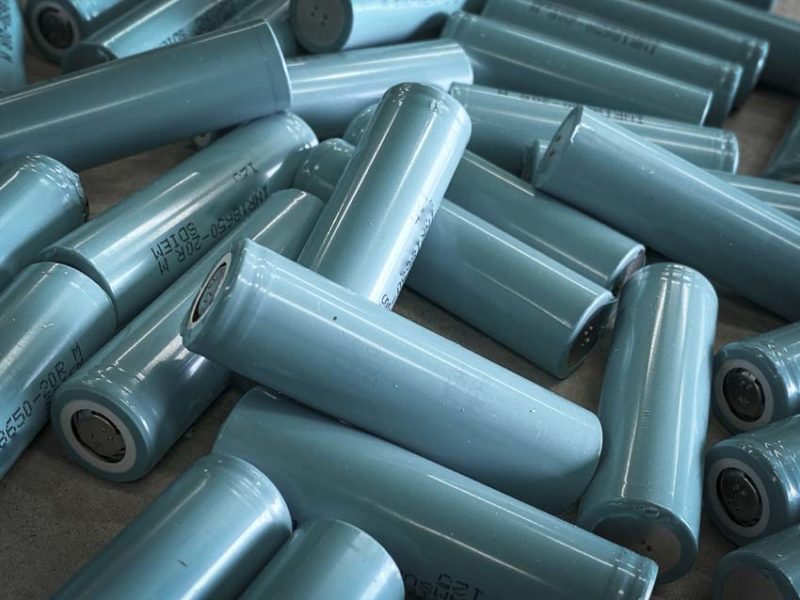
Like many of the top tool manufacturers, Milwaukee designs its own actual battery packs. Having started early, they just have more experience with lithium-ion than most. Milwaukee Tool theorizes that you can take the best battery cell in the world, but without great electronics and protection, the resulting pack performs poorly.
Check our article on All Milwaukee M18 batteries compared
Leveraging Technology and Talent
Milwaukee Tool quickly transitioned from trying to build battery cells to realizing they could retain these battery-geniuses on staff. They quickly redirected their efforts towards driving the partner manufacturers to maintain the best cell construction. Simultaneously, they adapted the technology and characteristics of the battery packs to meet user expectations.
These teams continued to control the production of the battery pack itself and also focus specifically on the development of the tool, pack, and charger electronics. The original lithium-ion battery packs had some electronics. Eventually, Milwaukee deployed additional electronics to monitor and implement new circuits. These analyzed the signals between the batteries and the tools and from the batteries to the chargers.
RedLithium technology was starting to take shape.
According to Milwaukee Tool, there ends up being three major places to focus when considering battery technology:
- Battery pack construction
- The actual lithium-ion cells within the pack
- The electronics within the battery pack (and consequently, the electronics within the tool and the charger)
Smart Milwaukee RedLithium Batteries
The transition from “dumb” batteries to “smart” batteries coincided with the advent of lithium-ion cells. Batteries went from virtually no electronics to systems that monitored all aspects of a battery pack’s charging and discharging functions. For example, during charging, the battery pack must speak to the charger, or overcharging can happen.
What’s an overcharge? If the battery charges beyond its capacity, the cell will break down and cease to work (or worse). Conversely, you could also take a battery pack over its temperature limits during the use of the tool. That can happen when the current draw exceeds limitations. That can melt your motor and let out the “magic smoke”. It can also damage the battery at the same time.
To avoid this, near-constant communication is happening during charging and discharging. The system monitors and adjusts the cells as well as the motor for optimum use and safety.
Editor’s note: Overcharging is when the battery pack is overloaded from the charger (power INTO the battery). Overload is when the tool is being used (power OUT FROM the battery) and the current draw goes up too high (for example, when the bit is too large or the torque too consistently high). In these cases, a well-designed tool turns itself off to protect both the tool and battery. A good battery-tool system monitors both aspects of this energy usage.
How Milwaukee RedLithium Technology Increased Runtime
The other side of the equation deals with run-time. With the advent of lithium-ion batteries, Milwaukee began providing discharge protection on the battery pack itself. This eliminated the need to discharge the battery fully by holding down the trigger, etc.
For anyone who has used NiCd or even NiMH, you are familiar with the memory effect and the tendency for the battery to lose its potential to hold a charge over time. Running it out was a frequent and popular method of regaining the battery’s maximum potential (or at least as much as possible). What users were really doing was “crashing the voltage” of the pack. Eventually, this hurt the battery.
Electronics stop the tool from discharging the battery to the maximum amount. This protects it from losing the ability to charge fully and completely. When a Milwaukee tool stops, it actually has a little charge left in the battery. The electronics step in to say “It’s time to charge the tool, quit working—you’re done.”
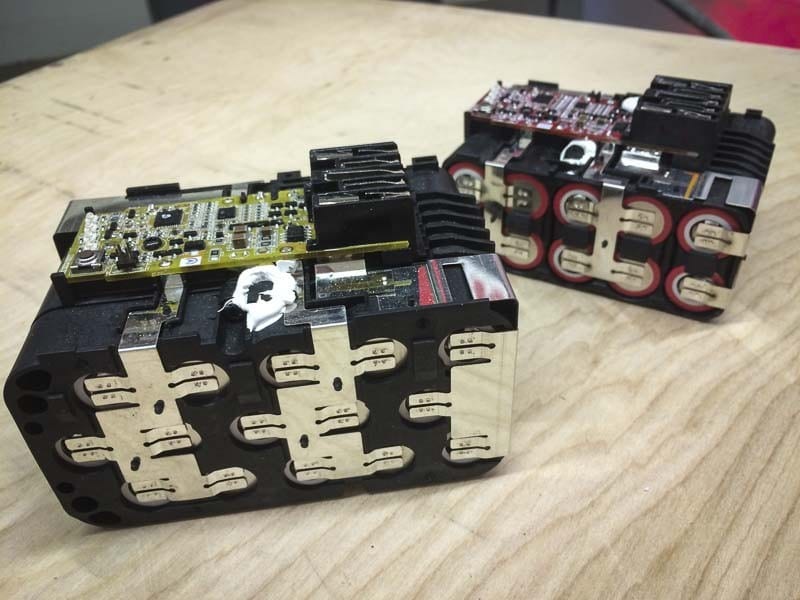
Thermal Protection in Milwaukee RedLithium Battery Technology
Thermal protection provides an equally important feature for the electronics that go into lithium-ion battery packs. This plays a role when cutting a bunch of lumber or any application using high amounts of torque or “trigger time”. In use-cases like this, you could easily take the pack up above its temperature threshold.
Milwaukee RedLithium electronics cut off the pack when a too-high threshold gets reached. What we find interesting is the observation that Milwaukee’s original lithium-ion batteries also contained electronic overload and thermal protection. Those early batteries simply cut out a lot earlier than newer RedLithium models. Runtime and torque capabilities took another leap with the advent of RedLithium High-Output batteries.
According to Paul, the electronics didn’t change all that much.
Advancements in cell technology, however, went through the roof.
Cell Construction and Chemistry Work Together
The newest Milwaukee RedLithium battery packs simply keep the overall battery cooler thanks to a change in cell construction and chemistry. The new potential and capability for increased load from the cells allowed the electronics to adjust, recognize this, and respond accordingly.
Remember those numbers above? That’s where all this increase came from. It’s real, not just marketing or a different way of measuring performance. The new RedLithium batteries literally build up heat slower and thus run longer before protection kicks in.
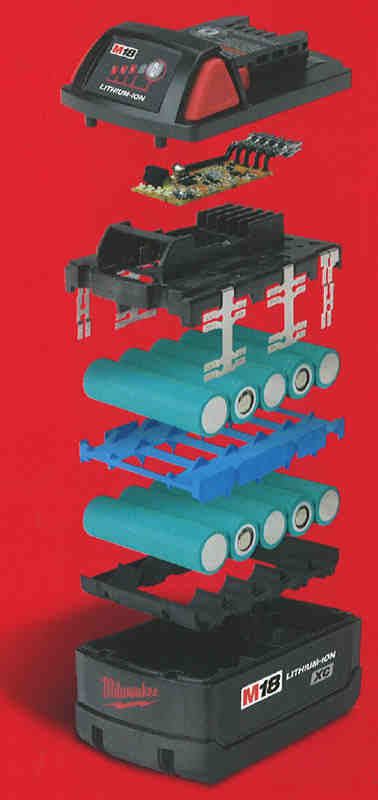
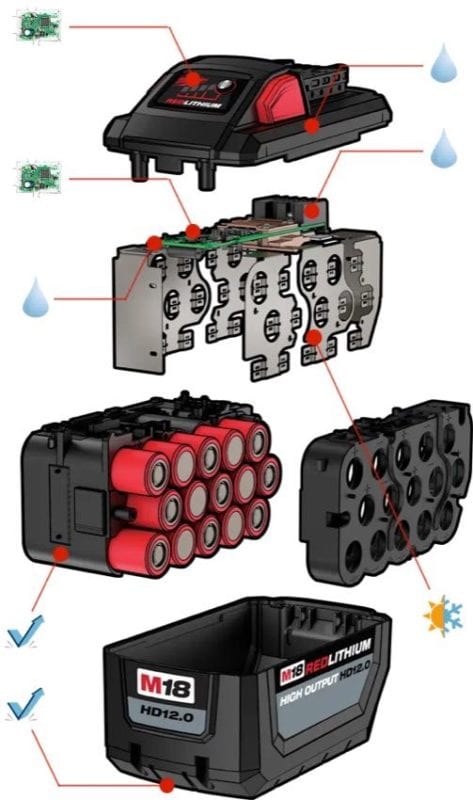
Here’s how RedLithium differs in terms of performance, from its predecessors (these are “up-to” numbers):
- 40% More Run-Time
- 20% More Speed
- 20% More Torque
- Fade-Free Power
And here’s how the actual durability of the RedLithium packs has changed:
- Operates Down to 0°F/-18°C
- Runs 20% Cooler
- Up to 50% More Recharges
- No Memory Effect
Now look at the values given to the newest RedLithium High Output packs:
- 50% more power
- Runs 50% cooler
The Intelligence Behind Putting the Brains in the Battery Pack
So the battery pack talks to the tool. The tool talks to the battery pack. Certainly, in terms of discharge or using the power tool, on-tool protection and monitoring are again key. But each tool has to know what’s happening with its battery – what its temperature is, charge level, etc. That way each of Milwaukee’s tools will react and respond appropriately and you don’t get a “one size fits all” approach to battery management and performance. That basically means that different thresholds for different packs are also now possible.
It really is a two-way street. If Milwaukee had simply placed overload thresholds only in the pack, then the pack would perform the same whether it was used with a flashlight or a circular saw. This is not the case with RedLithium (or their original lithium-ion batteries for that matter).
Slim Packs vs XC Fat Packs
Originally, Milwaukee RedLithium battery technology set limits on the battery packs. They did this so that users couldn’t use a Slim pack with a cordless circular saw, for example. These limitations were necessary at the time. Milwaukee wanted the ability to provide users with a satisfying experience. Pairing early slim packs with higher-torque tools would have yielded saws with slower cut times, more frequent stalls, and significantly reduced run-time.
Currently, RedLithium packs handle higher temperatures and dissipate heat more easily due to the advanced cell structure and electronics. With this, the “feel” of the tool is sustained, even with less run-time and torque. Since the tools don’t run out as quickly, Milwaukee opened up all of its tools to use the newer batteries.
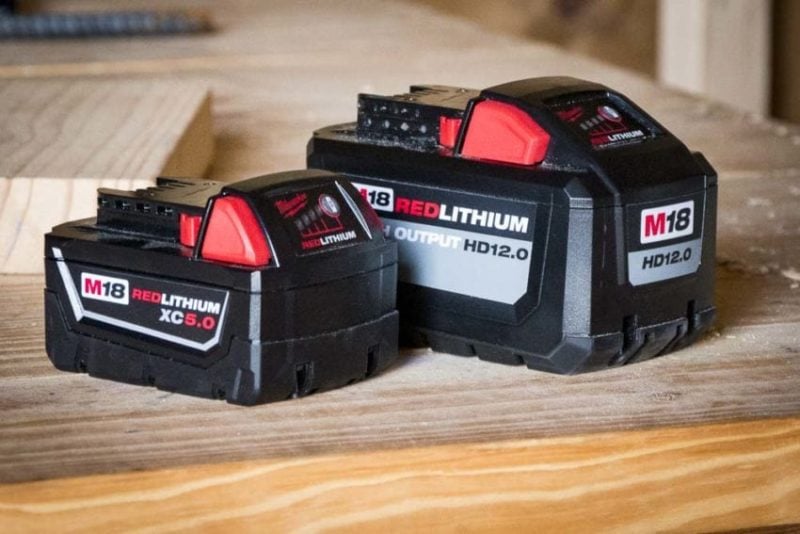
Milwaukee RedLithium High Output battery technology takes that even further. A High Output CP3.0 slim battery has more power and effective runtime than original RedLithium XC packs when used in high-demand tools. The larger XC8.0 and HD12.0 packs provide almost ridiculous levels of power that match or exceed what’s available in 120V corded tools.
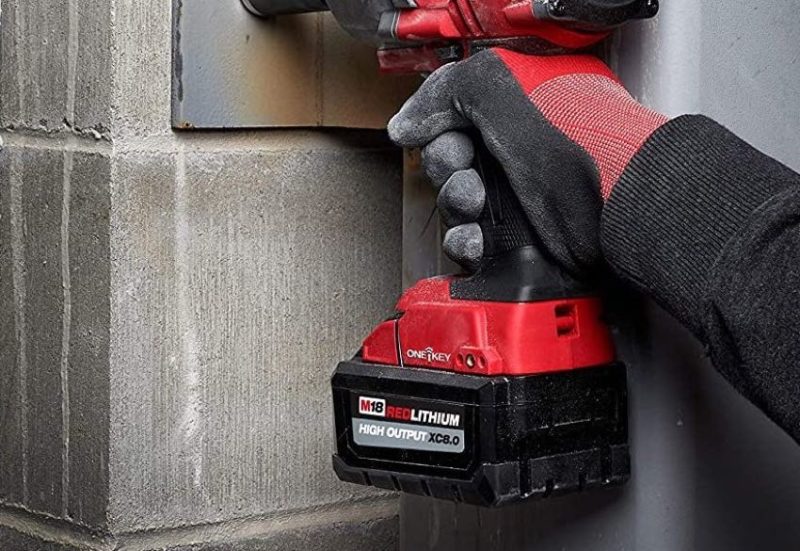
Another feature of comparing older to newer Milwaukee RedLithium batteries has to do with the primary gains realized from heat dissipation and heat management. The net effect is that—the harder a tool gets pushed, the more of an increase in run-time you realize. This is a factor of how much better the power curve is realized under load.
Larger Packs Still Deliver More Power
Don’t think that this means your Slim pack will result in equal torque for your cordless drill or high power hammer drill. There still remains a noticeable power difference between a 5-cell pack vs a 10-cell pack feeding the tool. The electronics set and manage some of this. However, the tool also has a natural current draw. While it can be limited by the battery pack electronics in terms of amperes per second, it still has an effect on total power.
To demonstrate how having more cells yields greater battery efficiency, we need to set up a scenario. This applies to Milwaukee RedLithium battery technology but also other tool batteries. Let’s assume a battery pack needs to deliver 20A of current to a tool. That would yield 360W of power.
Since we’re not talking about runtime, we won’t go into how long the battery could maintain that load. However, this is not an uncommon or excessive amount of current or power to deliver for a power tool under a reasonable load.
Let’s Do Some Simple Math
Here’s the equation for an 18V slim pack with five 3.6V battery cells. The total load we’ll put on that pack is 360W. For reference, power is expressed in Watts (Volt-Amps), current as Amps, and voltage by Volts. What we’re concerned with is looking at how each cell in the pack operates independently under a static load:
P (power) = I (current) x V (voltage)
360W = I x 18V (5 cells)
72W = I x 3.6V (1 cell)
I = 20A (for each of the 5 cells wired in series)
Each cell in that slim pack needs to deliver 20A and 72W of power. We know this because 360W/5 (cells) = 72W and each cell delivers the rated nominal 3.6V voltage in series. (20A = 72W / 3.6V)
What happens when we use a 2-layer 18V battery pack with two stacks of 5 cells (10 total) is that all of that power gets distributed across two parallel layers of cells wired in series. With each cell still rated at 3.6V, that means the cells only have to deliver 10A each. In general, Current is additive in a parallel circuit.
Less current draw equals less heat generated by the cell and pack, increasing the pack’s potential efficiency and performance. Often, this leads to runtime gains that exceed the mathematical multipliers of simply having more available cells.
Adding more parallel rows of battery cells means that each cell needs to deliver much less current for the pack to output the same amount of total current as demanded. In addition to having more runtime, these larger packs can typically deliver more power and do so while generating less heat.
Run-time or torque differences are greatly influenced by a battery’s ability to feed power to the motor. This greater current capacity “stiffens” the motor curve (at higher speed under load). This is where more torque and other advances take place with the larger 10-cell and 15-cell packs.
*Note: We got a lot of feedback regarding the original math used for series and parallel calculations of current across various battery packs. While our math was intended to illustrate the differences between the current draw of various packs, it didn’t take into account the fact that the current remains constant across a set of cells wired in series. As a result, we simplified our equations further and eliminated some of the incorrect examples. If you gave us feedback—thanks for your contribution to helping us more accurately clarify the issues involved.
Milwaukee RedLithium USB Batteries
Oddly enough, larger batteries didn’t get all the attention. Smaller batteries also benefitted from advanced technology. RedLithium USB batteries make a great case in point. These advanced cells now show up in headlamps and flashlights. They deliver rechargeable and replaceable cells to devices that previously required non-removable batteries or standard alkaline cells.
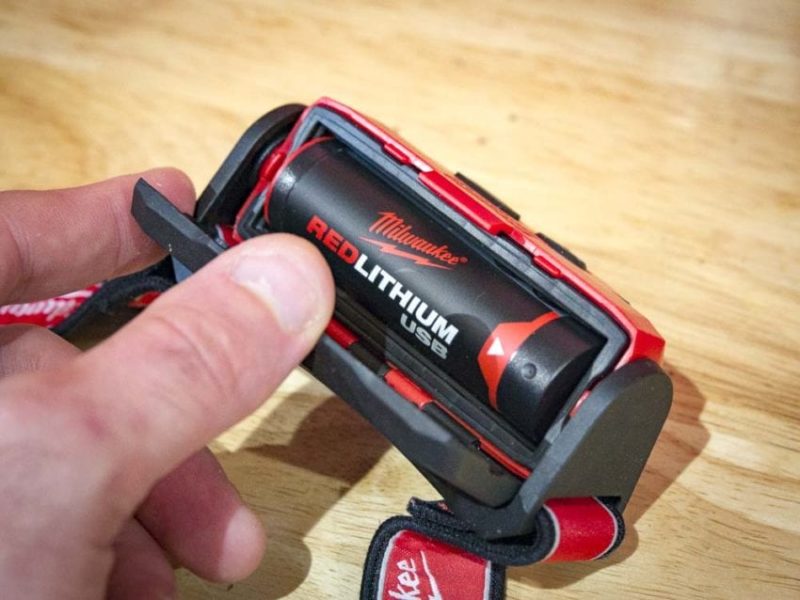
What’s in Store for the Future of Lithium-ion
We asked about the future of lithium-ion, and in particular, the potential use of prismatic cells as they advance. The bottom line is that cell technology (and Milwaukee RedLithium battery technology) will continue to progress, albeit slowly. And it’s good to remember that the cell is just 1/3 of the equation. You can have the best cell plus no electronics and literally destroy a tool. Consequently, you can have a poorly constructed battery pack that shatters when dropped, spilling out all the advanced electronics and cell technology onto the ground… no good either. If you lose just one weld on a battery pack, you lose the whole thing. Lithium-ion batteries give you no partial credit!
Increased amp-hour capacity and power density continue to improve. We already have new packs with denser, larger 21700 battery cells. Also, better cell impedance results in faster charging among other things). Given that iPads are really driving more advances in prismatics we may see some movement there, but for now, it’s not likely that prismatics will come to power tools anytime soon. They tend to have cooling issues and other considerations which prevent their use.
So while tool batteries may not look different in the near future, they are bound to last longer and charge more quickly. That’s very very cool for professionals and home users alike.
Editor’s Note #2: Here are a list of phrases that didn’t make it into this Milwaukee RedLithium battery technology article:
- “Paul seemed really charged up to talk to us about his new batteries”
- “We ran our tools through a battery of tests…”
- “Milwaukee really packed a lot into RedLithium…”

